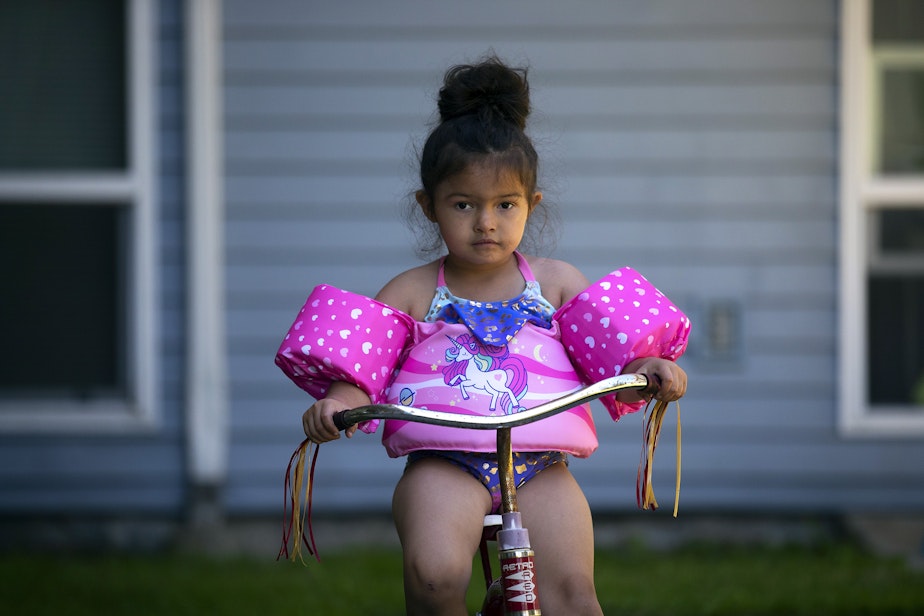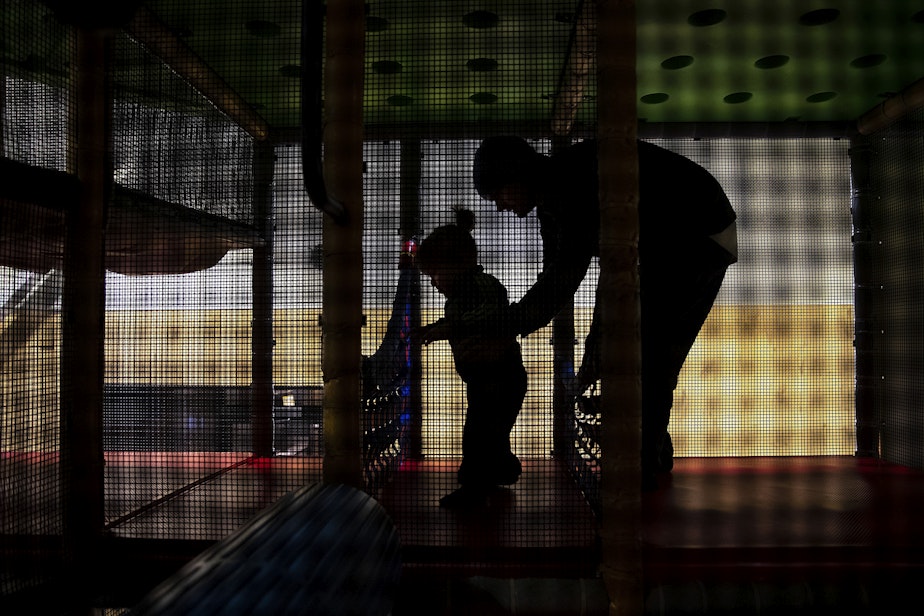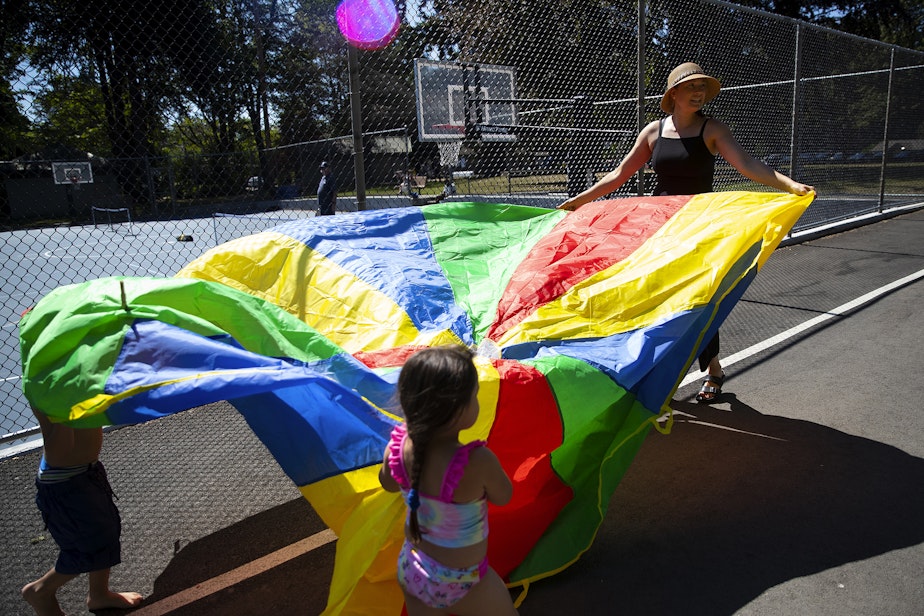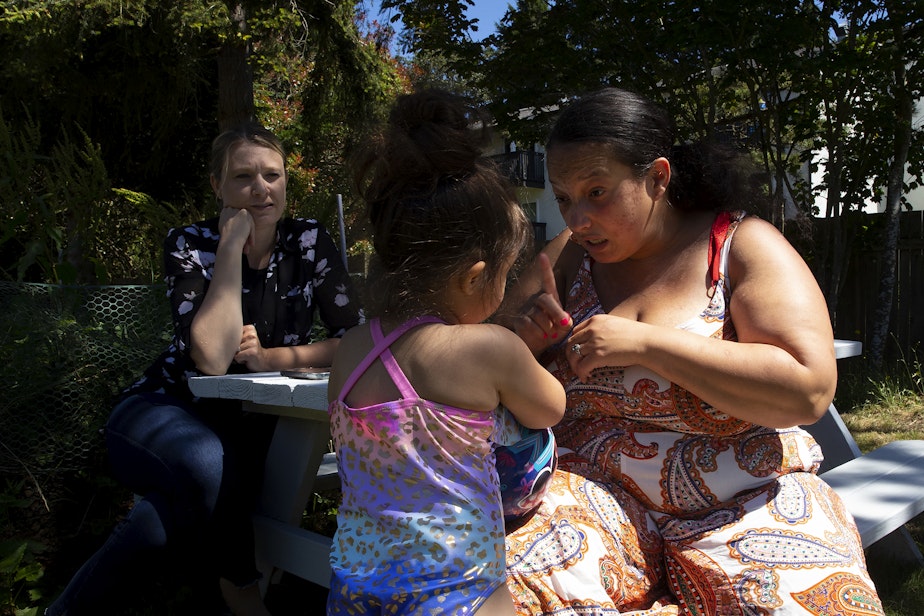A family's mental health journey out of crisis: Swimming Upstream

A family was ripped apart by drug addiction. Now, they're picking up the pieces one day — and several mental health-focused strategies — at a time.
This is Part 1 of KUOW's three-part series, "Swimming Upstream." This collection of stories details the mental health-focused journey of one Seattle-area family through crisis. KUOW is not using the shared last name of the father and children, to protect the children's identities.
Tynikki Arnold doesn’t keep tin foil in her kitchen, or anywhere in her home.
Same with metal spoons.
For her, these basic kitchen items can be triggers, and she’s still learning to trust herself.
Instead, she’s set up her compact apartment so that every time before she leaves, before the noise and temptation spill in from the all-hours shopping center across the street, her last steps through the entryway travel past a makeshift shrine of new routines. A neon rainbow of envelopes spreads across the wall, each envelope marked for a day and chore of the week. Below hangs a handwritten poster titled ‘Daily Schedule,’ listing the first two steps as ‘wake up,’ then ‘wake kids up.’ Alongside, an erasable monthly calendar has fallen partly out of use, out of sync with this afternoon in May.
For Tynikki , it's been the fight of her life to arrive at these family routines, and to be settled in this one-bedroom apartment in Lynnwood that she shares with her two children — daughter Vay, who’s almost 5, and son Messiah, who’s nearly 2.
Messiah’s age marks a major milestone for her — she decided to get clean from drugs, including fentanyl, when she found out about the pregnancy. “He put a nip in my ass,” Tynikki says. “If I didn't go to treatment, we would have lost both kids.”
Sponsored
This baby, born at the height of the pandemic, pushed her to finally stick it out in a recovery program, and to start down a path to be a full-time mother to Vay again, too. When Tynikki was using, she lost her daughter to foster care for nearly two years, until around Vay’s fourth birthday.
“I think that was the most traumatic era in our life," Tynikki says. "Every time we see a cop, she's like, ‘mommy, mommy, they're gonna take me’ or ‘they're gonna take me away.’ And I keep telling her not all cops are bad, not all cops are going to take you. Mommy's not gonna put you in that situation anymore, I promise.”
Swimming Upstream: a three-part series

Sponsored
Like her daughter, Tynikki also knows the hurt of childhood trauma and its mental health consequences. She experienced how the roots of mental health start young. So now, for this next generation, she sees an urgency to break their family cycle. And against many odds, she’s found a lifeline in a long-term home visitation program — and she’s grabbed on. The state’s Parent-Child Assistance Program provides intensive support for mothers with substance use disorders, and it’s giving Tynikki’s family a three-year runway to move from crisis to a more stable foundation.
RELATED: For moms in recovery, these home visitors offer a lifeline
The children’s father, Sean, nods along next to Tynikki on the couch, fidgeting his hands and bouncing his foot. Talking about that time they lost Vay makes them both emotional, edgy. They’ve been together for nearly 11 years and struggled past a dark chapter together — through drug addiction, homelessness, and family separation. That time is still at their heels.
As parents, they’ve set a clear goal to give their kids a more loving and protected childhood than what they experienced, and to break cycles of trauma that contributed to deep emotional wounds and a mess of bad decisions.
“The whole neglecting your kid, like my dad did to me, I ain't trying to do that to my kids,” Sean says. “Because I asked for these kids. We knew the responsibilities.”
Sponsored
He points toward a lone poster on the living room wall, with a mantra he embraces for his fledgling family: “If you want something you never had, you have to do something you've never done.”
This apartment gives them space to transition, to start again. It gives space where Tynikki can fill the hours baking cheese-bubbling pasta dishes or they can all cozy up to watch their favorite animated show, “Bluey,” featuring an Australian family of dogs and their tales of growing up.

Tynikki and Sean know it will be a prolonged and challenging effort to reverse some of the childhood trauma of Vay’s early years, and they’ve come to understand how she’s at a critical age for forming her coping responses, to both past and future stresses. Those responses, in large part, hinge on having a trusted bond with her parents, the caregivers who currently matter most in her life.
Vay is a nickname. The full name Vay’s parents gave her, their first child, reflects an upward-looking destination — it’s a play on the word ‘heaven.’
Sponsored
Combating adverse childhood experiences
I found my way to Tynikki and Sean while researching a story about youth mental health during the pandemic, and growing concerns about increased risks for adverse childhood experiences, or ACEs, for this affected generation.
RELATED: Reporter's notebook: tending to childhood scars in a pandemic, both old and new
These early life experiences before age 18 include abuse, neglect, violence, loss of a parent, or living with someone who abuses substances or is mentally ill. Decades of research show the higher your ACEs, the higher your risk for physical or mental health problems down the road — which can include poor performance in school, attachment disorders, chronic diseases, obesity, depression, unemployment, or substance use.
“ACEs are a major public health concern that are worsening as a result of the health, social, and economic repercussions of the COVID-19 pandemic,” states a March 2022 policy brief from the Weitzman Institute, a research group that partners with several leading public health schools in the country.
Sponsored
“Historically, child maltreatment rises with crises and economic downturn,” the brief notes, citing studies of the 2008 recession.
Risk factors for ACEs include economic hardship, social isolation, and household substance abuse — and these indicators spiked in Washington (and across the world) at various points in the pandemic. At the onset, unemployment shot up. Rates of adult depression and anxiety spiked. Meanwhile, deaths from opioids, especially fentanyl, continue to sharply increase.
Nationally, a recent study by the Centers for Disease Control and Prevention found that three out of four high school students reported at least one ACE during the pandemic, and these students were more likely to also report poor mental health and suicidal behavior. That’s just a snapshot. A fuller picture of the pandemic’s toll on children and families continues to come into view, as the data add up.
As I talked with youth therapists, school counselors, policy experts, and researchers about mental health solutions for school-age children, a theme emerged: we need to get to more kids and families sooner, before behavioral issues show up in the classroom.
“If you really want solutions, you need to go upstream,” one therapist put it, referring to “upstream” as the first few years of a child’s life. There’s a special armor that can grow in those early years to help ward off any potentially lasting harms of ACEs. That armor, or what’s formally called a ‘protective factor,’ stems from a child’s attachment to their parents or primary caregiver. This is the work Tynikki's family is doing now to address Vay’s early exposure to ACEs.
And while the ebb and flow of the crisis in Tynikki and Sean’s family is complex and specific to them, the ladder they’re climbing toward better mental health includes steps that can help support any family in stress.
Their path is not easy, and the coming months will test them in new and exhausting ways.
"I
want to show Toni my fishing pole!” Vay squeals, dancing up close to her mom in the living room. Sean takes her by the hand to help her find it in the closet.
She returns, beaming, with her first miniature fishing pole, still in the packaging.
Toni Gardner is a lead case manager with Sound Pathways, a social service nonprofit in Snohomish County, and she’s attached to this family through the Parent-Child Assistance Program — a voluntary, three-year home visitation program for pregnant and parenting women with substance use disorders. They began working together soon after Vay’s little brother, Messiah, was born and Tynikki’s life was in chaos. Initially, Gardner regularly spent 20 hours a week with the family. Now, at a stable midpoint, they’re down to a weekly visit.
“I’d love to go fishing with you,” Gardner gushes, sharing that she, too, has her own fishing pole.

Today, Gardner is starting a 10-week parenting course for Tynikki and Vay that’s designed to help them reflect on the ways they interact, and learn strategies to meet Vay’s unique social and emotional needs. This early intervention program, called Promoting First Relationships (PFR), aims to build up the emotional health between a child and caregiver, as a way to help set the mold for a secure and trusting relationship.
This parenting course is like a nesting doll that fits within a larger set of Gardner’s work with Tynikki’s family. The three-year program, which also includes things like education, employment, and housing support, represents the largest doll, the container for all the individual pieces.
“How Vay thinks and feels about herself and others starts from the first day of life,” Gardner reads from a handout. It's familiar territory since they both did this same program about a year ago with Messiah.
This round, the focus is on Vay, since she’s been back in Tynikki and Sean’s custody for nearly a year now.
“So we know that the social and emotional health…it always develops from the close relationships with the people we have near us, OK?” Gardner paraphrases from the worksheet. “And it encourages Vay to have healthy exploration to go play and learn new things, and know that she can come back and trust that mom's gonna be there, close to her.”
Vay dips in and out of a coloring project on the floor while Gardner and Tynikki go over some preliminary benchmarks about Vay’s current health, moods, and behaviors. The conversation turns to concerns about how Vay shows her feelings when she’s upset, like sometimes when mom says it’s time for a bath, or to stay close by at the store, or to put on a coat. When Vay doesn’t like the option, her instinct sometimes is to run — across a parking lot, a playground, or out of their backyard. And it’s a stressor for Tynikki when she’s unsure of how to help her daughter. Then, like a photo bomber on cue, Vay pounces on her mom with a hug.
“She does this when she knows that I'm overthinking, or if she notices that I'm upset — she'll come right up to me and give me hugs, right?” Tynikki says, shifting her attention to Vay.
This young girl has a keen radar to her mom’s emotions. Often, over the next several months when the family faces stress or Tynikki's emotions run high, Vay’s response is to get in her mom’s face with a hug or a close look eye to eye, reminding them both to take a breath. Her emotional instincts seem beyond her years.
Their assignment for this first day of social and emotional learning: 15 minutes on the floor, playing together. No phones, no TV — just mom and Vay. Gardner props up her iPad to record a video she’ll review later with Tynikki.
“What color is the polar bear?’ Tynikki prompts Vay as they sit on the living room carpet, pulling toys from a blue rubber bin. “White!” she squeals in a voice that sounds young for this girl who will start kindergarten in just a few months.
“Good job! What is this?”
“Monkey!”
“And who's a monkey in the family?
“Mommy!”
“All right, I'll take it,” Tynikki laughs, moving on to the next stuffed animal in the pile.
“Do you want to try and build something with me?” Tynikki asks. Vay shrieks and wiggles around, not ready to focus on one thing.
“I found mom! I found mom!” she announces, wrapping her mom in another hug.
Then, just before the play time ends, Vay gets a little wound up.
“Don’t choke me,” Tynikki warns, as Vay hangs off of her mom’s neck, giggling. “Why is this happening?” Tynikki groans, hurt and frustrated. (Vay also threw a toy earlier that hit her in the eye.) “You’re asking for negative attention and I don’t like that.”

Vay has been hitting her mom a lot recently. They’re working to understand why.
A week later, Tynikki and Gardner review the video together and zero in on the small successes and pain points. Gardner pauses the screen to note how Vay’s attention clings to her mom, delighted to have her as a playmate. They pause to analyze a moment when Tynikki firmly warns Vay not to climb on the toy box.
This habit to pause and reflect is something Gardner sees moms start to do more instinctually in real-time, as they work through this parenting course week by week. And the video playback is key, to help set a truer picture in their mind about how their child responds to them.
It can be tough for Tynikki to shake the guilt she feels about her daughter seeing her at her worst. This video is proof that Vay sees her as so much more.
Getting started early
Brain development in early childhood is sometimes called the “soak it up” stage. The science is clear that it’s a time of rapid growth that shapes the brain’s architecture — starting with interactions between infants and their caregivers.
According to a report from Harvard’s Center for the Developing Child, “this is how the interpersonal relationships young children experience with adult caregivers (within and outside the family) get “inside the body” and influence lifelong learning, behavior, and physical and mental health — for better or for worse.”
For early childhood development expert Monica Oxford, the infant light bulb went off several years into her career, when she encountered the 10-week home visiting program Promoting First Relationships (PFR) — the same video feedback program Toni Gardner is now doing with Tynikki’s family.
“This is really where the meat of human relationships is, and this is really where the origins of adolescent problem behavior and adolescent mental health are coming from,” said Oxford, a research professor in the University of Washington’s School of Nursing and executive director of the Barnard Center for Infant Mental Health.
Until that point, Oxford said her earlier graduate work with adolescents and her training as a social worker “really missed the mark” on childhood mental health. She was also drawn to how Promoting First Relationships’ model flips the script for people, by helping them identify personal strengths that can move them forward rather than the obstacles that might hold them back.
“In a sense, it still is a focus on adolescent mental health and behavioral health,” Oxford said regarding infant mental health. “But starting so young that, hopefully, we change the trajectories of children so that they have better outcomes before they need clinical services.”
Oxford describes infant mental health, focused on children 5 and younger, as “the ability of children as they develop to be flexible in the face of stress and bounce back.” It includes, for example, their ability to sit and pay attention when necessary in school or other settings, and also the ability to be curious and free to explore when opportunities arise.
Since 2005, Oxford has been a lead or co-lead investigator on several studies funded by the National Institutes of Health, to track the outcomes of the 10-week video program as an intervention tool for families in challenging circumstances, including parents involved with the child welfare system, reunified birth families, and Indigenous families in rural settings.
One key measure of success is a more sensitive and responsive interaction between a child and caregiver, observed through the two-year studies. The findings also show reductions in children acting out and fewer sleep problems. Among families under investigation by Child Protective Services, Oxford’s research found that children were two and a half times less likely to be placed into foster care and separated from their family.
This year, the Promoting First Relationships intervention model gained a key federal endorsement for evidence of the program’s effectiveness, making it eligible for additional federal funding. That means organizations, like Sound Pathways where Gardner works, can tap into more funding options to offer or expand this program.
Oxford’s team trains providers across the state who want to embed this parenting course in their work with families, including in child welfare, pediatric care, early learning, and in other home visitor programs.
While Oxford believes this approach can help anyone have better relationships, she notes that the general intent is to support caregivers who also experienced childhood adversity, or who are often working through mental health issues or some other environmental stressor.

“Many of us don't have a map for healthy relationships,” Oxford said. “We don't know what it feels like to have a responsive caregiver who holds us when we're emotionally upset, contains our negative feelings, and helps us regulate and recover. Many of the families we work with didn't experience that. Many of the caregivers were themselves, victims of child maltreatment, and so they don't have a map. And they love their children, and they want the best for their relationship with their child, and they're hungry to figure it out.”
Washington state helps fund a variety of voluntary home visiting programs to support low-income or at-risk parents at different stages, from pregnancy to kindergarten. Some work with teen moms to address economic and health needs, for example, while others focus on early childhood development.
One common thread among the more than 9,000 families currently served in home visiting programs across Washington is that “the needs are complex…and that long-term relationship pays off,” said Erica Hallock, a member of the state’s Home Visiting Advisory Committee. She's also director of policy and advocacy for Washington's branch of Start Early, a nonprofit early childhood development organization headquartered in Illinois.
“The idea behind home visiting is just providing that parental support, and it looks different for each family,” Hallock said. The program Tynikki is in represents the more complex end of the spectrum.
In response to a legislative request, the advisory committee recently provided recommendations for the state’s next two-year budget, calling for a significant increase to bolster the home visitor workforce and expand capacity. According to Hallock, current home visiting programs reach less than 10% of eligible families, indicating a need to cover more ground. The committee flagged a particular need to invest more in rural areas and in organizations led by people who are Black, Indigenous, and people of color.
The pandemic left a wake through the system, including higher than normal turnover for home visitors, according to the advisory committee. Its latest report noted that “wages are a morale and retention issue,” in connection with a 2019 report that showed 23% of home visitors in the Pacific Northwest region receive some type of public assistance. Hallock also noted how home visitors are still seeing the pandemic’s “snowball effect” among the families they serve, as they try to catch up from health or financial setbacks.
"We are still facing times of uncertainty," Hallock said. "Families faced times of uncertainty before the pandemic, and it's just been amplified."
Read the next story in KUOW's "Swimming Upstream" series.
Liz Jones is a 2021-22 fellow with the Rosalynn Carter Fellowships for Mental Health Journalism. This story is part of a project focused on solutions for childhood adversity and trauma connected to the Covid-19 pandemic. If you have a story you’d like to share, please email her at ljones@kuow.org.




